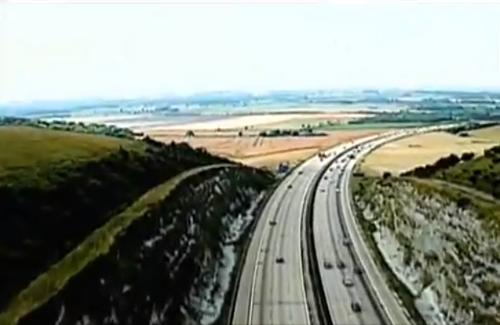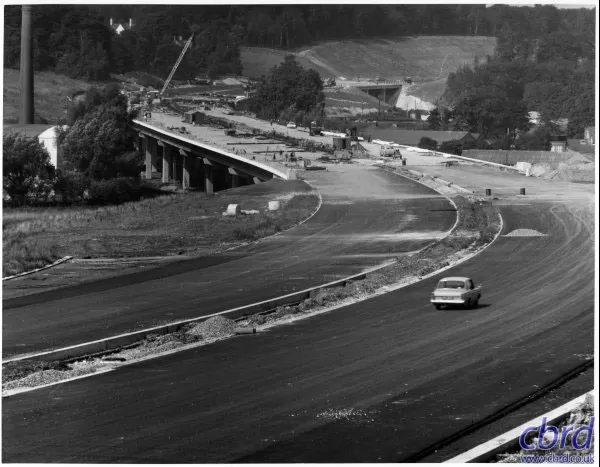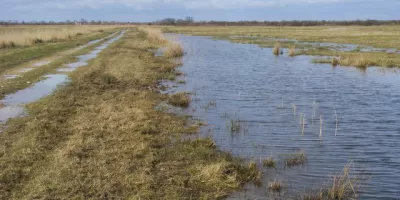The M40 turns fifty years old this summer. How much do you know about the London to Birmingham motorway?
The present decade is fifty years on from the roadbuilding heyday of the 1960s, so it naturally contains a whole host of "fifty years ago" moments for the motorway network. We won't be marking every single one (we probably wouldn't have time), but here's a nice one. In June 1967, the first section of the M40 opened around the south and west of High Wycombe, between what is now junction 4 (Handy Cross) and 5 (Stokenchurch).
By the 1970s the M40 was a continuous route from London to Oxford, and in the early 1980s a decision was taken to extend it to Birmingham to relieve the M1 and M6 by providing a second motorway from the South East to the West Midlands. The final section of this new cross-country motorway opened in 1991, and today it still feels a bit different to other motorways thanks to its more youthful appearance.
Today there are 89 miles of the M40 - an improvement on the original eight. How well do you know them? To celebrate 50 years of the M40, and because fifty things seemed a few too many, here are five things you might not know about the London to Birmingham motorway.
1. The whole M40 is managed by a private company
In the late 90s and early 2000s, Private Finance Initiative (PFI) contracts were everywhere, and the roads were no exception. A consortium called UK Highways M40 Ltd. successfully bid for a Design, Build, Finance and Operate (DBFO) contract that involved widening the M40 between junctions 1A and 3 to add a fourth lane each way and to replace a concrete surface between Stokenchurch and Wheatley with tarmac.
Normally DBFO contracts involve the company then running things for 30 years after they've built it - that's how it works with hospital buildings, and that's also how it works on other DBFO roads. But in this case, UK Highways' contract required them to run the whole of the M40 from London to Birmingham, which they do to this day, funded by ghost tolls. The contract has about another ten years to run.

2. Its route was changed by the most ingenious anti-roads protest ever
The M40 between junctions 8A and 9 was originally planned to run through an area of wetland called Otmoor, which was controversial to begin with and became even more so when the Public Inquiry recommended another route and the Department of Transport decided to build it there anyway.
Friends of the Earth acquired a field on the line of the route, which they named Alice's Meadow (after Alice in Wonderland, said to have been inspired by the landscape there). The land was broken up into 3,500 tiny plots, which were all then sold to 3,500 different people, many of them overseas. To build the motorway, the DTp would have to pursue compulsory purchase procedures against thousands of people, none of whom would be easy to find, not all of whom would even be resident in the UK, and all of whom would be entitled to appeal. It would almost certainly mean huge legal bills and long delays. Whatever you might think about environmental protests against road projects, you have to admit that this one was rather brilliantly inventive.
Partly as a result of the protest, the line of the motorway was amended to the one recommended by the Public Inquiry and Otmoor was saved. The law has since changed so that tiny parcels of land - which could be bought and sold freely at the time - are now subject to fees that would mean the same tactic wouldn't work today.
3. The first section of M40 wasn't called M40
...or was it?
The original section of the road, which forms the western part of the High Wycombe Bypass between junctions 5 and 6, is listed in contemporary Ministry of Transport documentation and on several maps as A40(M) - a number that would have been quite normal at the time for a motorway bypass of a town on the A40. The number M40 never gets a mention. Some maps even apply the number to the next section, east of there, that completed the bypass of High Wycombe a year or so later.
Three years later, and all the available evidence from 1970 suggests the High Wycombe Bypass went by its present name M40, and the sections to either side that connect it to London and Oxford then opened in 1973 and 1974 respectively, so the A40(M) didn't last long - if it ever existed at all.
In fact the number A40(M) appears to have been used for planning the road and is ubiquitous in documentation, but it looks like it was never actually used for real and the road was M40 from the start - it's just that some mapmakers jumped the gun.
4. It might have met the M5, but it didn't
Approaching Birmingham, the M40 ends on the M42 at Umberslade Interchange. You don't have to be an expert in junction design to see that this three-way junction is laid out so the main through-route actually connects the M40 with the M42 to the west.
The plans for motorway numbering in this area are all over the place and appear to have changed more often than the responsible minister's socks during the 1970s, but there's evidence (unearthed by SABRE member Truvelo) that one early plan, suggested in late 1971 and agreed early in 1972, was for the M40 to continue right through from its present terminus to end on the M5.

In the end, it took another 20 years for the motorway to get that far, by which time the M42 had made itself comfortable.
5. It's a star of film and TV
Before the first section of M40 had opened, the bridge carrying Bigmore Lane across the new motorway became the star of the Thunderbird 6 movie when wartime pilot Joan Hughes flew a Tiger Moth plane under it in a daring stunt. The Ministry of Transport had agreed on the condition that the plane's wheels were on the tarmac when it went under - but on approach Hughes decided the crosswind made a landing too risky, so she flew under instead without touching down. She, and the company she worked for, found themselves in court the following year on charges of dangerous flying - but were acquitted.

In the 1990s, the M40 had a second brush with fame as it became the star of the title sequence to the BBC sitcom The Vicar of Dibley, which started every episode with a helicopter shot of the Stokenchurch cutting.

That starring role landed it another big part when, in 2004, the eastbound approach to the M25 became the setting for a Channel 4 ident - with CGI roadworks added and a tower of yellow signs forming the channel's logo. The ident was used for a number of years so this short stretch of road might be one of the most televised sections of the motorway network as a result.

Those are our five favourite M40 facts - if you have your own to share, add a comment below.
Comments
Just south of J15 at Warwick, the M40 crosses the River Avon on two separate and quite distinctive bridges, with the carriageways separated by about 50yds. The southbound bridge is a concrete arch dressed in stone, while the northbound is a beam bridge on circular columns. I would guess the southbound side bridge is older and previously served a different purpose - does anyone know what it was?
Yes, that's right. Warwick already had a southern bypass before the M40 came along, and the motorway uses part of its line. The A452 leading on from junction 14 is what remains of it - it then went over the Avon using what is now the bridge carrying the southbound M40 and ended at Longbridge Roundabout.
The bypass opened in the mid 1960s and was originally part of the A41, which was downgraded and renumbered when the M40 arrived.
Just before the final section opened in 1991, I took part in a sponsored bike ride along the northbound carriageway between 8A and 9 in aid of Oxfam, involving multiple circuits of a there-and-back-again route over 10km of the road. Although it was a bit windy, it didn't rain or snow, and we got T-shirts that said "I cycled the fast lane of the M40".
Driving westbound along the normal miles of queues every Sunday night to get through the two-lane section under junction 4, I was wondering, is this a hangover from it being one of the oldest sections? There is space for three lanes to continue through.
Also the roadworks to sadly remove the clinging-on SOX lighting between junctions 1 and 1a are progressing but the signage is a mess. If you join the M40 from M25 AC you pass the 50mph terminal signs then immediately the massive NSL end of VSL sign. Plus often the gantry signs indicated advisory 60mph in the 50mph SPECs section. Not very good advice!
Yes, the section from J4 to J5 was the first to be built, and was D2. The whole of the rest of the original motorway (Denham to Wheatley - opened in stages in the early '70s) was D3 from the start, so there was a lane-drop for the A404 as you approached J4 from London. The widening of the J4-J5 section to D3 was triggered by the Birmingham extension, but the main line under J4 was left as D2, presumably on the grounds that J4 is very busy anyway, so a lane-drop was acceptable, though it still seems somewhat cheap.
My claim to fame is I worked on the M40 stretch of road between Stokenchurch & Milton when it was being constructed.There is a big bridge at Lewknor where I actually helped the road engineer to mark out where the bridge would be constructed and after working on all the bridges (13 in all ) as a concreter I was there for the grand opening two years later.Main construction was carried out by M J GLEESON.and earthworks by P. MERRIMAN.
The Stokenchurch Cutting is known in these parts as “Chicken **** Gulley” since my highly-esteemed brother-in-law maintains that chicken guano was used to stabilise the slippage-prone sides during construction.
I saw the item about Alices Meadow and Otmoor. During WWII Otmoor was the site of an RAF bombing range. I wonder if the real reason for the M40 avoiding Otmoor was due to the fact that a clearance of the former range would have had to be done?
Add new comment
Sources
- A40(M) number: Pathetic Motorways.
- Tiger Moth stunt at Bigmore Lane bridge: Thunderbirds Wiki; Wikipedia.
Picture credits
- Photograph of sign at M40 J12 cropped and scaled from an original by the Highways Agency and used under this Creative Commons licence.
- Image of UK Highways sign taken from Google Maps Streetview.
- Photograph of the M40 Loudwater Viaduct under construction by Robert and used with permission.
- Photograph of Otmoor taken from an original by Shaun Ferguson and used under this Creative Commons licence.
- Map scan showing A40(M) is courtesy Pathetic Motorways.
- Extract from Civil Service memorandum on numbers for M40 and M42 is taken from a photograph by SABRE member Truvelo.
- Still of Tiger Moth plane stunt is copyright Century 21 Productions/MGM-UA and used under fair dealing rules.
- Still from the Vicar of Dibley opening titles is copyright BBC and used under fair dealing rules.
- Still from Road Signs (2004) copyright Channel 4 and used under fair dealing rules.




Sadly one of the worst motorway crashes ever, occurred on the M40. On 18th November 1993 a minibus crashed into a road maintenance vehicle parked on the hard shoulder near Warwick, killing 12 school children and their teacher.
Second longest length of motorway to open in one go (Warwick - Oxford) apart from the first length of the M1.
Also notable for not having any services when it opened